Understanding Camera Optics & Smartphone Camera Trends, A Presentation by Brian Klug
by Brian Klug on February 22, 2013 5:04 PM EST- Posted in
- Smartphones
- camera
- Android
- Mobile
The Imaging Chain
Since we’re talking about a smartphone we must understand the imaging chain, and thus block diagram, and how the blocks work together. There’s a multiplicative effect on quality as we move through the system from left to right. Good execution on the optical system can easily be mitigated away by poor execution on the ISP for example. I put arrows going left to right from some blocks since there’s a closed loop between ISP and the rest of the system.
The video block diagram is much the same, but includes an encoder in the chain as well.
Smartphone Cameras: The Constraints
The constraints for a smartphone camera are pretty unique, and I want to emphasize just how much of a difficult problem this is for OEMs. Industrial design and size constraints are pretty much the number one concern — everyone wants a thin device with no camera bump or protrusion, which often leaves the camera module the thickest part of the device. There’s no getting around physics here unfortunately. There’s also the matter of cost, since in a smartphone the camera is just one of a number of other functions. Material constraints due to the first bullet point and manufacturing (plastic injection molded aspherical shapes) also makes smartphone optics unique. All of this then has to image onto tiny pixels.
Starting with the first set of constraints are material choices. Almost all smartphone camera modules (excluding some exceptions from Nokia) the vast majority of camera optics that go into a tiny module are plastic. Generally there are around 2 to 5 elements in the system, and you’ll see a P afterwards for plastic. There aren’t too many optical plastics around to chose from either, but luckily enough one can form a doublet with PMMA as something of a crown (low dispersion) and Polystyrene as a flint (high dispersion) to cancel chromatic aberration. You almost always see some doublet get formed in these systems. Other features of a smartphone are obvious but worth stating, they almost always are fixed focal length, fixed aperture, with no shutter, sometimes with an ND filter (neutral density) and generally not very low F-number. In addition to keep modules thin, focal length is usually very short, which results in wide angle images with lots of distortion. Ideally I think most users want something between 35 mm or 50 mm in 35mm equivalent numbers.
I give an example lens catalog from a manufacturer, you can order these systems premade and designed to a particular sensor. We can see the different metrics of interest, thickness, chief ray angle, field of view, image circle, thickness, and so on.
During undergrad a typical homework problem for optical design class would include a patent lens, and then verification of claims about performance. Say what you want about the patent system, but it’s great for getting an idea about what’s out there. I picked a system at random which looks like a front facing smartphone camera system, with wide field of view, F/2.0, and four very aspherical elements.
Inside a patent is a prescription for each surface, and the specification here is like almost all others in format. The radius of curvature for each surface, distance between surfaces, index, abbe number (dispersion), and conic constant are supplied. We can see again lots of very aspherical surfaces. Also there’s a doublet right for the first and second element (difference in dispersion and positive followed by negative lens) to correct some chromatic aberrations.
What do these elements look like? Well LG had a nice breakdown of the 5P system used in its Optimus G, and you can see just what the lenses in the system look like.


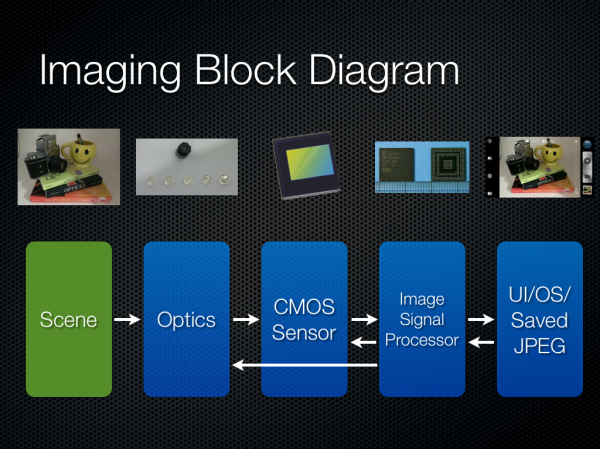
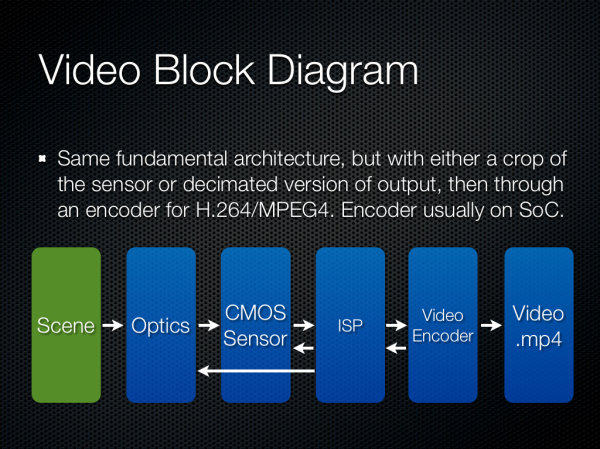
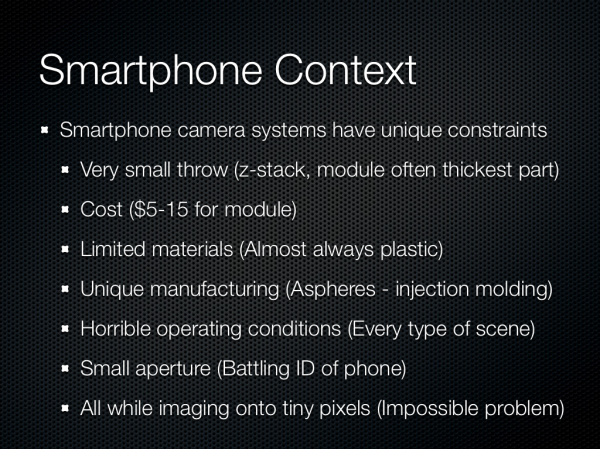
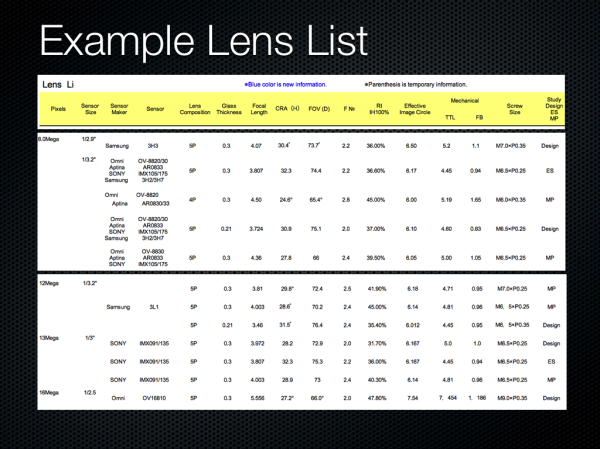
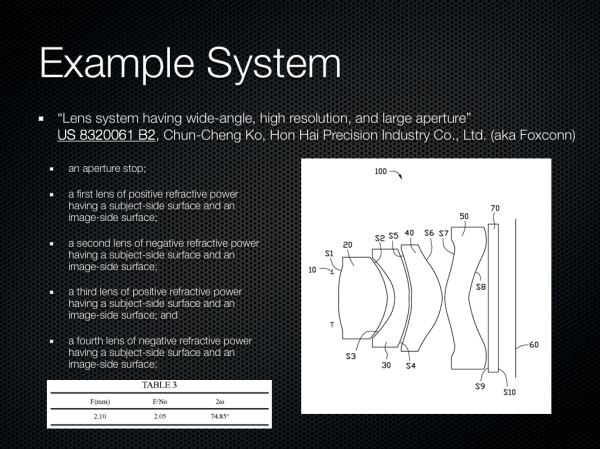
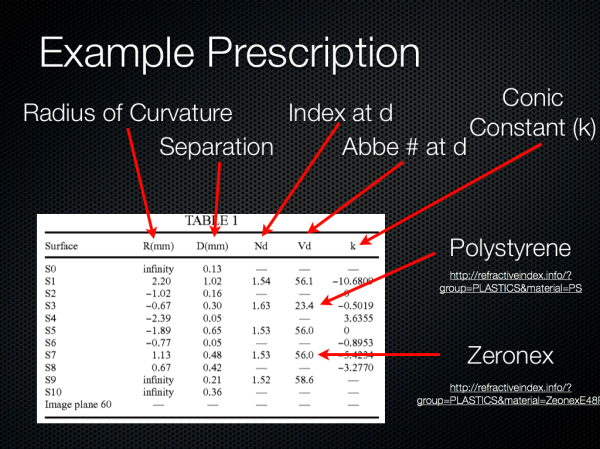
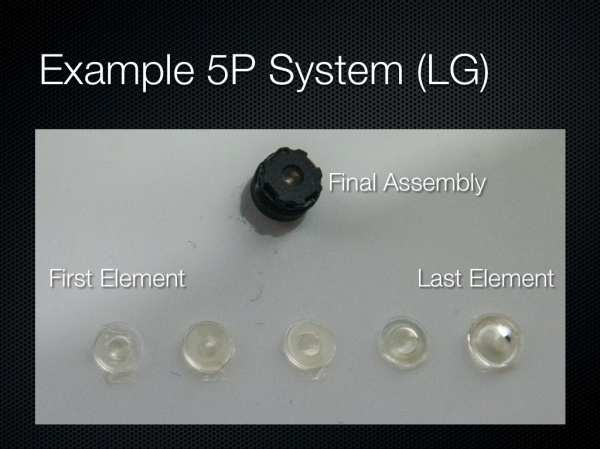








60 Comments
View All Comments
MrSpadge - Sunday, February 24, 2013 - link
You're right, conceptually one would "only" need to adapt a multi-junction solar cell for spatial resoluition, i.e. small pixels. This would introduce shadowing for the bottom layers similar to front side illumination again, though. Which might be countered with vias through the chips, at the cost of making manufacturing more expensive. And the materials and their processing become way more expensive in general, as they will be CMOS incompatible III-V composites.And worst: one could only gain a 3 times higher light sensitivity at maximum, so currently it's probably not worth the effort.
mdar - Thursday, February 28, 2013 - link
I think you are talking about Foveon sensors, used by Sigma to make some of their DSLR cameras. Since photons of different colors have different energies, they use this principle to detect color. Not sure how they do it (probably by checking at which depth the electron is generated), but there is lot of information on web about it.fuzzymath10 - Saturday, February 23, 2013 - link
one of the non-traditional imaging sensors around is the foveon x3 sensor. each pixel can sense all three primary colours rather than relying on bayer interpolation. it does have many limitations though.evonitzer - Wednesday, February 27, 2013 - link
Yeah, like only being in Sigma cameras that use Sigma mounts. Who on earth buys those things? The results are stunning to see, but they need some, well, design wins, to use the parlance of cell phones.They also need to make tiny sensors. AFAIK they only have the APS-C one, and those won't be showing up in phones anytime soon. :)
ShieTar - Tuesday, February 26, 2013 - link
The camera equivalent of a 3 LCD projector does exist, for example in so-called "Multi-Spectral Imager" instruments for space missions. The light entering the camera aperture is split into spectral bands by dichroic mirrors, and then imaged on a number of CCDs.The problem with this approach is that it takes considerable engineering effort to make sure that all the CCDs are aligned to each other with sub-pixel accuracy. Of course the cost of multiple CCDs and the space demand for the more complex optical system make this option quiet irrelevant for mobile devices.
nerd1 - Friday, February 22, 2013 - link
I wonder who actually tested the captured image using proper analysing software (Dxo for example) to see how much they ACTUALLY resolve?And I don't think we get diffraction limit of 3um - see the chart here
http://egami.blog.so-net.ne.jp/2011-07-11
We have 1.34um at f2.0 and 1.88um at f2.8.
Typical 8MP sensor have 1.4um photosites so 8MP sensors looks like an ideal spot for f2 optics. (Yes, 13MP @ 1.1um is just marketing gimmick I think)
In comparison, 36MP Nikon D800 has 4.9um photosite size, which is diffraction limited between f5.6 and f8.
jjj - Friday, February 22, 2013 - link
"smartphones are or are poised to begin displacing the role of a traditional point and shoot camera "That started quite a while ago so a rather disappointing "trends"section. Was waiting for some actual features , ways to get there. and more talk about video since it's becoming a lot more important.
Johnmcl7 - Friday, February 22, 2013 - link
Agreed, the presentation feels a bit out of date for current technology particularly as you say phone cameras have been displacing compact cameras for years - I'd say right back to the N95 which offered a decent 5MP AF camera and was released before the first Iphone.I'm also surprised to see no mention of Nokia pretty much even though they've very much been pushing the camera limits, their ultra high resolution Pureview camera showed you could have a very high number of pixels and high image quality (which this article seems to claim isn't possible even with lower resolution devices) and the Lumia 920 is an interesting step forward in having a physical image stabilisation system.
Also with regards to shallow depth of field with F2, that's just not going to happen on a camera phone because depth of field is primarily a function of the actual focal length (not the equivalent focal length) so to get a proper shallow depth of field effect (as in not shooting at very close macro distances) a camera phone would need a massive aperture many stops wider than F2 to counter the very short focal length.
John
Tarwin - Saturday, February 23, 2013 - link
Actually it makes sense he doesn't mention all that. He's talking about trends, the Pureview did not fit into the trends, both in quality and sensor size.Optical image stabilization doesn't fit in either as it only affects image quality in less than ideal situations such as no tripods/shaky hands. But he did mention the need for extra parts in the module configuration shouldnthat be part of the setup.
And in his defence of the comment ofndisplacing P&S cameras, he says "smartphones are or are poised to begin displacing the role" so he's notnsaying that they aren't doing it already, he gives you a choice in perspectives. Also I don't think you can say the N95 displaced P&S at the market level, only in casual use.
Manabu - Friday, February 22, 2013 - link
What about the "large" sensor 41MP Nokia 808 phone? It is sure a interesting outlier.And point & shot cameras still have the advantage of optical zoom, better handling, and can have bigger sensors. Just look at S110, LX7 or RX100 cameras. But budget super-compact cameras are indeed in extinction.